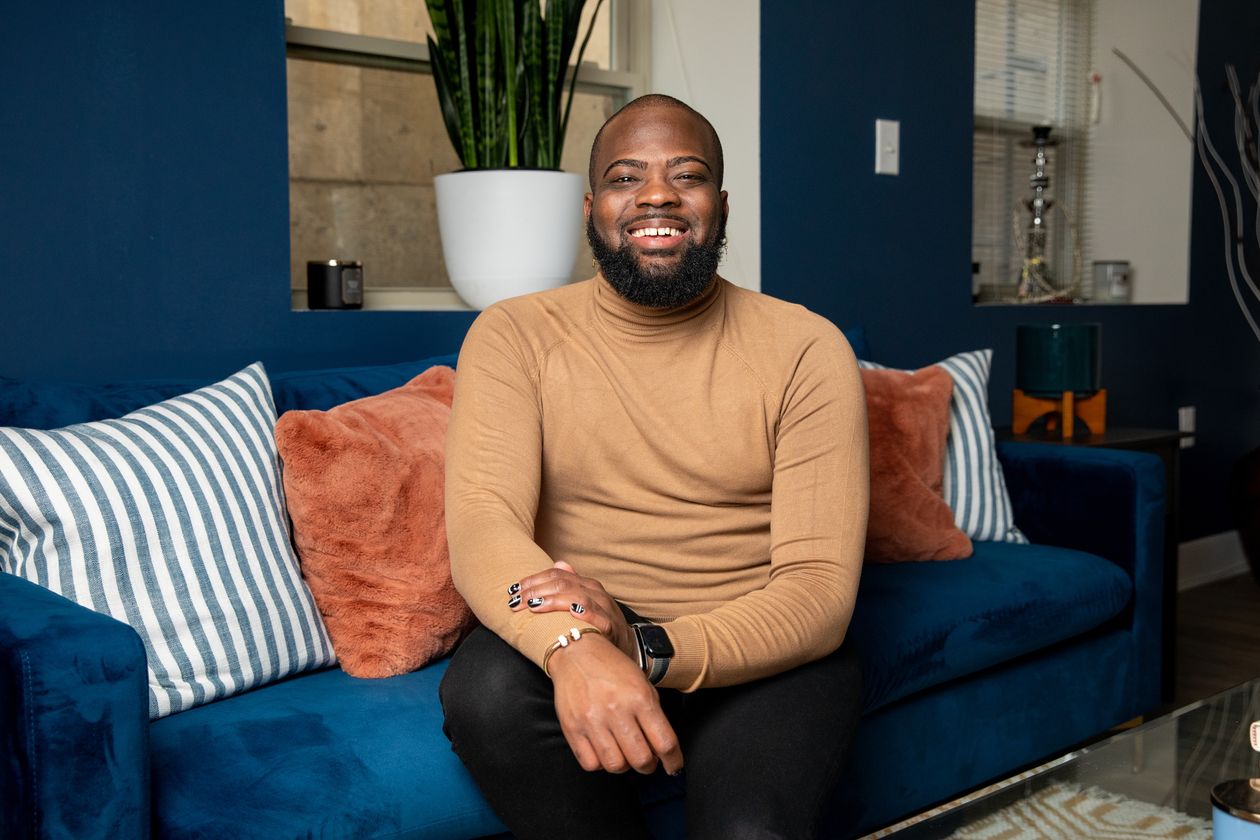The Covid-19 pandemic threatened to ruin Americans’ finances. For many, the opposite happened.
Though initial shutdowns caused unemployment to surge to levels not seen since the Great Depression, trillions of dollars in government stimulus and the economy’s swift, if turbulent, recovery helped many families reach a new level of financial security.
The first two rounds of stimulus payments lifted 11.7 million people out of poverty, according to the Census Bureau. Americans built up $2.7 trillion in extra savings. Some expect that, combined with rising wages, to provide them with lasting stability despite the return to more normal spending patterns and rising inflation.
When Washington, D.C., shut down in March 2020, resident Preston Mitchum became consumed with anxiety that his loved ones would get sick. While that period was filled with “so many horrible things for so many people,” he said, there was a financial silver lining.
Mr. Mitchum’s spending fell dramatically. Traveling internationally, going out to eat with friends and getting a haircut became, for a time, impossible. The pause in his student-loan payments freed up $500 a month.
The 35-year-old, who works in public policy for a nonprofit, was able to save consistently for the first time in his adult life. He put away between $300 and $500 some weeks, eventually building up an emergency fund from about $2,000 to about $10,000. He also paid off $2,000 in credit-card debt, which boosted his credit score.
Though Mr. Mitchum doesn’t think he will ever fully pay off the $200,000 he borrowed to pay for his two law degrees, his improved financial situation has given him hope that he will be able to buy a home and begin investing.
“It was such a sigh of relief,” he said. “As a person who grew up poor, there’s not a day that goes by when I won’t check my bank account.”

Preston Mitchum, on Friday in Washington, said he saved consistently and paid off credit-card debt, and is hoping to buy a home and begin investing.
Photo: Amanda Andrade-Rhoades for The Wall Street Journal
Not everyone benefited equally, and some say the future already looks more tenuous. The federal government’s stimulus checks, expanded unemployment insurance and monthly child tax credit have ended, and the pause on payments and interest on student loans will end soon. The Omicron variant of the coronavirus is driving up infections and disrupting businesses.
But Americans of all income levels socked away more money during the pandemic, according to Moody’s Analytics estimates based in part on government data.
The personal saving rate—a measure of how much money people have left over after spending and taxes—hit a record 33.8% in April 2020, according to the Bureau of Economic Analysis. The rate averaged just under 8% for the two years before the pandemic began.
The median checking-account balance at JPMorgan Chase & Co., the country’s largest bank, spiked with all three rounds of stimulus checks. Customers hung onto a chunk of each check, pushing the median balance up more than 50% to nearly $1,900 at the end of July 2021 from about $1,230 two years earlier. U.S. bank deposits are around their highest level on record.
Jessica Donamaria, 33, was furloughed from her job as a travel agent when the pandemic began. Ms. Donamaria and her computer-technician husband, Zack, who live in Minot, N.D., with three small children, worried about burning through their $2,000 in savings.
Ms. Donamaria’s unemployment benefits arrived within a few weeks and matched her previous take-home pay. Stimulus checks and the monthly child tax credit followed. The couple kept expenses down by buying groceries in bulk and using coupons in the McDonald’s app.
Their savings account grew to about $6,000. They also paid off about $1,000 in debt from a basement renovation. Ms. Donamaria returned to her job full-time last year. The Donamarias said they think the extra savings will put them on a better long-term financial trajectory.
The family put some of their child tax credit toward activities they couldn’t afford before: dance lessons for their 7-year-old daughter and karate for their 5-year-old son.
The Donamarias worried their son would have trouble listening and following instructions when he started kindergarten in the fall. “He started karate and within two weeks, I was like, ‘He’s ready for school,’ ” Mr. Donamaria, 32, said.
White-collar workers who kept their jobs and worked from home did better than wage earners who were laid off. Only 58% of people who were laid off in 2020 and unemployed in November 2020 said they could pay all of their monthly bills, compared with 92% of people who kept working from home, according to Federal Reserve data.
“Layoffs during the pandemic were concentrated among lower-wage workers,” the Fed said in a May report on the state of Americans’ finances. “This exacerbated pre-existing disparities in financial well-being in the United States.”
And though Americans’ cash cushions are much larger than before, they often remain too small to ensure lasting financial security. JPMorgan found that while its poorest customers had about 70% more in their accounts at the end of September than they did two years earlier, their median balance was just $961.
Lower-income households need about $2,500 to adequately weather periodic financial emergencies, said Fiona Greig, co-president of the JPMorgan Chase Institute, the bank’s in-house think tank. While median balances increased, “How much longer [are they] going to sustain people?” she asked.
At recent rates of spending and saving, households in the bottom 20% of income will burn through their extra money by the third quarter of 2023, according to an October report from Goldman Sachs Group Inc.
Wealthier households, meanwhile, saved more and have yet to fully resume spending on things like travel. Families in the top 10% of income were sitting on $1.5 trillion in extra savings in the third quarter of 2021, more than all income groups below them combined, Moody’s Analytics chief economist Mark Zandi estimates.
“The high-income households, they’re not going to spend it,” Mr. Zandi said. “They view it as wealth.”
Families in the top 20% of income put more than a third of their extra savings into other assets such as investment accounts or down payments on homes, the Goldman Sachs report said. Lower-income groups mostly kept it in the bank or used it to pay down debt.
Brian Cockerline and Harleigh Thornton, both 25, were a few years into their careers in the New York area when the pandemic started. Mr. Cockerline works for an insurer, and Ms. Thornton is a food scientist.
The couple moved in with Mr. Cockerline’s parents in New Jersey after their apartment lease expired in July 2020.

Ms. Thornton and Mr. Cockerline walked their dog near home in Morristown, N.J., on Friday.
Photo: Michelle Gustafson for The Wall Street Journal
They paid down about $25,000 of their $70,000 in student loans. They also put about $15,000 toward their car loans and kept up Roth IRA and 401(k) contributions.
The couple were often able to put about $1,000 a month into their savings account. “It’s definitely been a big opportunity to set an even better foundation,” Mr. Cockerline said.
They moved into a new place over the summer and married in September. They increased spending on Yankees games and other pastimes. Both earned promotions and raises at work, which allowed them to keep saving. They hoped to put money toward a down payment for a home but are holding off because of rising prices and bidding wars in their preferred suburban New Jersey market.
“If everything hadn’t gone crazy, we would have been looking at buying a house,” Mr. Cockerline said. “At the same time, if everything hadn’t gone crazy, we wouldn’t have moved in with my parents and saved so much.”
Landon Hill, a 20-year-old student at the University of San Diego, saved more than $3,000 in the year-plus that he attended school remotely. He invested a few hundred dollars of that using a Robinhood Markets brokerage account, including a portion of a $500 hazard paycheck for his $13-an-hour job at a nursing home.
“I don’t want it to just go and pay off the bills. I want to see it grow,” Mr. Hill said.

Landon Hill, a college student in San Diego, saved money and invested during the months he attended school remotely, and found a higher paying job.
Photo: Rozette Rago for The Wall Street Journal
Last summer, a San Diego restaurant struggling to keep up with staffing needs hired him on the spot as a food runner for about $27 an hour including tips. His Robinhood account is up to about $1,100.
Despite the higher wages, his checking-account balance is slowly dwindling. That is due in part to the rising cost of basics from inflation. He pays about $60 to fill up his Subaru every other week, up from $45 a year ago.
Mr. Hill is also spending more to enjoy his abbreviated in-person college experience. He bought a new surfboard and went to Disneyland with friends. This Halloween, he got three different costumes for the festivities.
“I’m kind of making up for the lost time and all the money I didn’t spend,” Mr. Hill said.
About 8% of extra savings went toward paying down debt, the Goldman Sachs analysis found. Outstanding credit-card debt, which consumers often repay first because it carries high interest rates, fell markedly during the pandemic, according to the New York Fed. Defaults are still below pre-pandemic levels.
Shirley Young, a social worker in New Orleans, had accumulated around $45,000 in credit-card debt over the years as she struggled to cover big expenses with her annual salary of around $40,000. During the pandemic, the 69-year-old put some of her stimulus money toward paying it down. She has about $31,000 left. “The stimulus really helped me keep up-to-date with my bills,” Ms. Young said.
Her financial situation still feels tenuous. She had to pay $3,000 to board and train her dog after it bit a neighbor. Her washing machine broke. Her roof was damaged in Hurricane Ida, and she is still not sure what her insurer will cover. And her daughter, who had helped with bills, was laid off from two jobs. One was tied to the city’s tourism industry and the other was at a distillery that ran into supply-chain issues.
She has other debts, like a mortgage she isn’t set to pay off until she is 85. And she doesn’t think her nonprofit employer will offer pay increases anytime soon.
“These things come up and have to be dealt with. Every time it seems that I think I’m going to see the light at the end of the tunnel, then something else happens,” Ms. Young said.
Write to Rachel Louise Ensign at [email protected]
Copyright ©2022 Dow Jones & Company, Inc. All Rights Reserved. 87990cbe856818d5eddac44c7b1cdeb8








